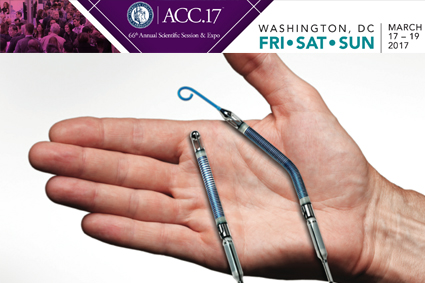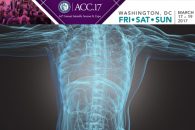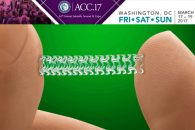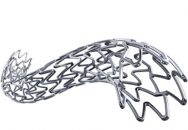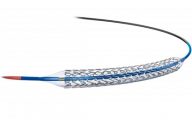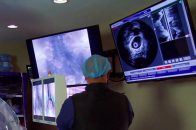This small study suggests the early use of Impella ventricular support device in patients undergoing AMI complicated by cardiogenic shock could help lower mortality rate in this population. However, study design should moderate our enthusiasm, mainly because of the cost of this device. Detroit Cardiogenic Shock Initiative has stressed early identification of cardiogenic…
FFR-Guided ACS Revascularization Apparently Superior to Culprit Vessel Treatment
Using fractional flow reserve (FFR) to guide revascularization of all functionally significant lesions in the setting of acute coronary syndrome appears to improve outcomes over treating only the culprit artery, according to the Compare-Acute trial. This study, conducted at 24 centers in Europe and Asia, enrolled 885 patients who were stable following successful primary angioplasty and…
Higher Radiation Dose in Patients and Operators with Radial Approach (RAD-MATRIX Dosimeter)
Both physicians and patients are exposed to higher radiation doses during radial access PCI compared to femoral, according to this large contemporary study on high volume PCI operators of ACS patients. Even though the difference in radiation exposure was relatively small for patients (approximately 10% higher for radial PCI) this translated into double the…
DECISION-CTO: Prevailing Questions on CTO Rechanneling
The first and only randomized trial on chronic total occlusion (CTO) revascularization versus optimal medical therapy in stable patients has disappointed interventional cardiologists. According to Dr. Seung-Jung Park, who presented the study, evidence suggests that optimal medical therapy is a reasonable initial treatment strategy for chronic total occlusion, when compared with angioplasty. Critics…
ABSORB III: More Events with Absorb Than With Xience at Two Years
The two year outcomes of ABSORB III, presented at the scientific sessions of the American College of Cardiology 2017, have shown the bioresorbable scaffold Absorb GT1 (BVS, Abbott Vascular) was associated with increased risk of target vessel failure, compared against the everolimus eluting stent Xience. At 25 months, target vessel failure occurred in 11%…
Pregnancy and Risk of Spontaneous Coronary Artery Dissection: How to Proceed
Courtesy of Dr. Pablo Baglioni. Between the years 2000 and 2015, the authors of this article searched for reports on spontaneous coronary artery dissection (SCAD) in pregnant or immediate post-partum women aiming at defining the clinical characteristics of this pathology and offering management recommendations. Information on 120 women was analyzed; 116 were between 22…
SYNERGY vs. XIENCE in Complex Real-World Patients
Courtesy of Dr. Guillermo Migliaro. Technological advancements in drug-eluting stents (DES) have shown significant improvement as regards the safety and efficacy of these devices. DES are considered to be the golden standard for the treatment of percutaneous coronary interventions. DES with permanent or durable polymers (DP) have been associated with local inflammatory reactions and…
Biolimus and Everolimus Eluting Stents in Coronary Artery Disease: Similar Safety?
Courtesy of Dr. Guillermo Migliaro. Events such as very late stent thrombosis and restenosis after first generation DES stenting were associated to the inflammatory response of site implantation. The presence of a durable or permanent polymer was thought to play a central role in said inflammatory process, which caused, among other things, delayed re-endothelialization and…
Left Main Target Lesion Revascularization: When is it Necessary?
Courtesy of Dr. Agustín Vecchia. Incidence, predictors and impact of target lesion revascularization (TLR) on unprotected left main stenosis initially treated with second generation DES have not yet been clearly defined and this is the main goal of the present study. This is a multicenter observational retrospective study of patients with unprotected left main…
Interventionists Used to the Radial Approach No Longer Associated with Worse Femoral
The transradial approach is being increasingly adopted as preferred access site, since it is more comfortable for patients, reduces vascular and bleeding complications, is cost effective and reduces mortality in high risk patients. This has created concern about the fact that operators and institutions could become unfamiliar with the transfemoral approach. The aim of…
Why We Should Use IVUS in Complex Coronary Lesions
Courtesy of Dr. Carlos Fava. Drug eluting stents (DES) have shown benefits in terms of restenosis vs. conventional bare metal stents (BMS). Many of the advantages of DES depend on correct implantation, especially in complex lesions. In complex lesions, the use of intravascular ultrasound (IVUS) provides important information on lesion length, vessel diameter, calcification…
